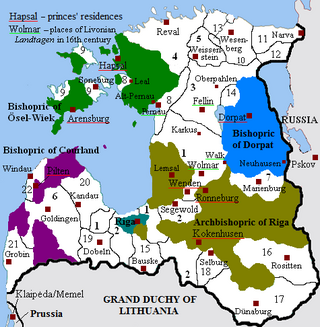
Livonia or in earlier records Livland, is a historical region on the eastern shores of the Baltic Sea. It is named after the Livonians, who lived on the shores of present-day Latvia.

Daugavpils is a state city in south-eastern Latvia, located on the banks of the Daugava River, from which the city gets its name. The parts of the city north of the river belong to the historical Latvian region of Latgale, and those to the south lie in Selonia. It is the second-largest city in the country after the capital Riga, which is located some 230 kilometres to its north-west.

Rēzekne is a state city in the Rēzekne River valley in Latgale region of eastern Latvia. It is called The Heart of Latgale. Built on seven hills, Rēzekne is situated 242 kilometres east of Riga, and 63 kilometres west of the Latvian-Russian border, at the intersection of the Moscow – Ventspils railway and Warsaw – Saint Petersburg Railways. It is the 7th largest city in Latvia.

Ludza is a town in the Latgale region of eastern Latvia. Ludza is the oldest town in Latvia and this is commemorated by a key in its coat of arms. Ludza is the administrative centre of Ludza Municipality that is located nearby the Russian border. The population as of 2020 was 7,667.

Latgale, also known as Latgalia is one of the Historical Latvian Lands. It is the easternmost region of the country and lies north of the Daugava River. While most of Latvia is historically Lutheran, Latgale is predominantly Roman Catholic: 65.3% according to a 2011 survey. After the Counter-Reformation it was the northernmost predominantly Catholic province or region in Europe. There is a considerable Eastern Orthodox minority (23.8%), of which 13.8% are Russian Orthodox Christians and 10.0% are Old Believers. As of 2020, the region's population was 255,968.

Historical Latvian Lands or formerly Cultural regions of Latvia are several areas within Latvia formally recognised as distinct from the rest of the country. These are: Kurzeme (Courland), Zemgale, Latgale, Vidzeme, and Sēlija (Selonia). While some of these regions are seen purely as culturally distinct, others have historically been parts of different countries and have been used to divide the country for administrative and other purposes.

Semigallia, also spelt Semigalia, is one of the Historical Latvian Lands located to the south of the Daugava river and to the north of the Saule region of Samogitia. The territory split between Latvia and Lithuania, previously inhabited by the Semigallian Baltic tribe. They are noted for their long resistance (1219–1290) against the German crusaders and Teutonic Knights during the Northern Crusades. Semigallians had close linguistic and cultural ties with Samogitians.
Koknese is a town in Aizkraukle Municipality in the Vidzeme region of Latvia, on the right bank of the Daugava River. It has a population of nearly 3,000.

Alūksne ) is a town on the shores of Lake Alūksne in northeastern Latvia near the borders with Estonia and Russia. It is the seat of Alūksne municipality. Alūksne is the highest elevated Latvian city, located in East Vidzeme Upland at 217 m above sea level. The high elevation of the city affects the social and physical arrangement of the place.

Vidzeme is one of the Historical Latvian Lands. The capital of Latvia, Riga, is situated in the southwestern part of the region. Literally meaning "the Middle Land", it is situated in north-central Latvia north of the Daugava River. Sometimes in German, it was also known as Livland, the German form from Latin Livonia, though it comprises only a small part of Medieval Livonia and about half of Swedish Livonia. Most of the region's inhabitants are Latvians (85%), thus Vidzeme is the most ethnically Latvian region in the country.

The Livonian crusade consists of the various military Christianisation campaigns in medieval Livonia – modern Latvia and Estonia – during the Papal-sanctioned Northern Crusades in the 12–13th century. The Livonian crusade was conducted mostly by the Holy Roman Empire and the Kingdom of Denmark. It ended with the creation of Terra Mariana and the Danish duchy of Estonia. The lands on the eastern shores of the Baltic Sea were one of the last parts of Europe to be Christianised.
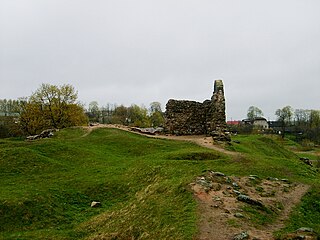
Rēzekne Castle ruins are located in the downtown of Rēzekne, Latvia, a city in the center of Latgale. The castle served as a base of the local Livonian order landlords until the 16th century and also as the main military support base for battles against Russians and Lithuanians. Today, fragments of the stone walls and the foundation can be seen on the ancient castle hill.
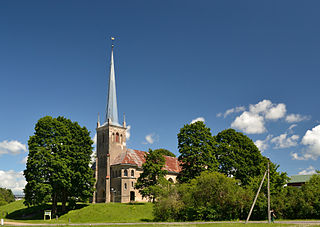
Rõngu is a small borough in Elva Parish, Tartu County, southern Estonia. Prior to the administrative reform of Estonian local governments in 2017, it was the administrative centre of Rõngu Parish.

Gaujiena Castle is a castle in the historical region of Vidzeme, in northern Latvia. It was built between 1236 and 1238. Severely damaged in 1702 during the Great Northern War, the structure was abandoned.

Lielvārde Castle is a castle in Lielvārde, a town in Ogre Municipality in the Vidzeme region of Latvia.The castle was built at the steep bank of Daugava River, overseeing this important medieval waterway, before 1248 by Albert of Buxthoeven, an archbishop of Riga. During the Livonian War, Lielvārde Castle was destroyed by Russian troops in 1579. Its ruins are conserved up to the level of the second floor.

Dinaburga Castle, also known as Vecdaugavpils or Vecpils, is a castle located in Naujene Parish, Augšdaugava Municipality in the Latgale region of Latvia, east of Daugavpils. It is strategically situated on a high bank of the Daugava River. It was built between 1273 and 1277 by the Livonian Order, and destroyed by Russian troops before 1577. Nowadays, fragments of the foundation are exposed.

Alūksne Castle is a castle of Teutonic Knights in current Alūksne, North-Eastern Latvia.
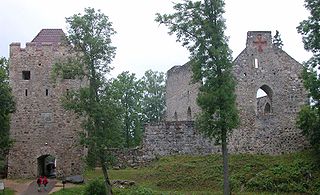
Sigulda Medieval Castle ruins are located on the edge of the Gauja valley in Latvia. The original castle was built in 1207 as a castellum type fortress, later rebuilt into a convent type building. The residence of the Land Marshal of the Livonian Order since 1432.
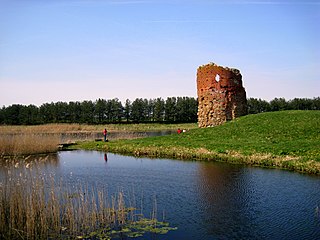
Piltene Castle is a Bishopric of Courland castle in the town of Piltene in the historical region of Courland, in western Latvia. Until the 16th century it served as a capital of Bishopric of Courland.

Valmiera Castle was a castle in Valmiera, Latvia. Today its ruins lie in the city centre.






















